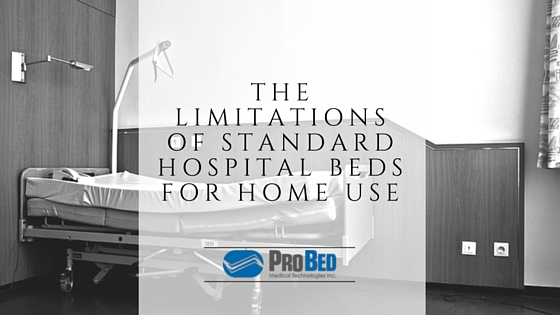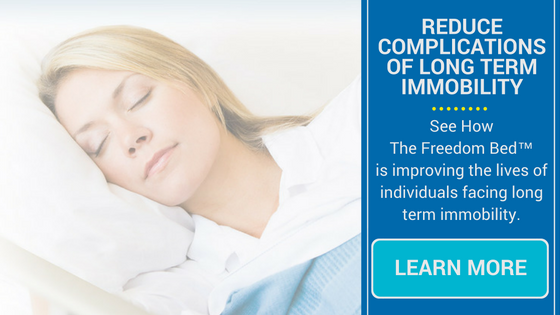
Sometimes when an individual becomes critically ill or sustains an injury bed rest is required. Although there are varying degrees of immobilization, all persons facing immobility challenges must remain somewhat mobile so as to avoid negative health complications associated with the immobility itself; furthermore, choosing one of the best hospital beds for home use requires finding a bed that offers the caregiver ease of use while providing the disabled person with optimal comfort to ensure that he or she maintains healthy sleeping habits. The bed should also provide solutions to avoid potential complications related to immobility.
Manually Turning Persons With Disabilities Can Be Challenging
In order to avoid the many complications associated with immobility, caregivers need to reposition the disabled person frequently (A minimum every two hours to prevent the possibility of pressure sores developing). Turning the person manually is difficult even for medical staff and frequently requires assistance from multiple staff members; therefore, caregivers who are turning the person in their traditional consumer or hospital bed at home will most likely find this task cumbersome as well. Furthermore, manual patient turning is responsible for an inordinate number of caregiver back injuries.
The Importance of Turning Disabled Persons Regularly
There are numerous complications that can occur when an individual is immobile for long periods of time. Some of these complications include:
- Pressure Ulcers (Bed Sores) - Now referred to as Pressure Injuries’
- Deep Vein Thrombosis (DVT) that may lead to Post-Thrombotic Syndrome (aka Postphlebitic Syndrome)
- Superficial Venous Thrombosis
- Superficial Thrombophlebitis
- Pulmonary Embolism
Bed Sores
Elderly people are more prone to develop pressure injuries or pressure sores than younger patients are. Seniors are at increased risk of pressure injuries because they usually have minimal amounts of fat beneath their skin; in addition, blood flow to their skin may be inhibited. A bedsore can begin to form in as little as two hours. Moving or rotating the person frequently is essential to reduce the likelihood of pressure injuries developing.
Deep Vein Thrombosis - Post-Thrombotic Syndrome - Pulmonary Embolism
Deep vein thrombosis refers to a condition in which blood clots form in the deep veins (typically, the affected veins are located in the legs). A blood clot may form if a vein becomes injured, blood flow to the heart is too slow or the person has a disorder that causes the blood to clot. Most often, DVT occurs in the legs and pelvis; however, it can also occur in the arm.
Signs and symptoms associated with post-thrombotic syndrome include:
- Swelling
- Vein Dilation
- Pain
- Changes in Skin Color
- Venous Ulcers
If a blood clot forms, the leg or arm may swell. Anything that prevents the ability of the blood to flow freely or clot properly can potentially cause a blood clot to form. If a blood clot forms, breaks loose and travels to the lungs, the person has what is referred to as a pulmonary embolism: A pulmonary embolism can be prevented with the use of anticoagulants.
Pulmonary Embolism
A pulmonary embolism is a life threatening condition, which is why caregivers need to know what signs and symptoms to look for.
Symptoms may include:
- Discomfort or chest pain that increases when the person coughs or takes a deep breath.
- Unexplained shortness of breath.
- A rapid pulse.
- Feeling dizzy, lightheaded or fainting.
- Coughing up blood.
Superficial Venous Thrombosis
Superficial venous thrombosis refers to a condition in which blood clots develop within the shallow, superficial veins. These veins can also become inflamed (without clotting). When superficial veins become inflamed and also develop clots, the condition is referred to as superficial thrombophlebitis.
Traditional Hospital Beds Lack Lateral Rotational Support
Traditional hospital beds do not provide lateral rotational support to assist the person in shifting and turning while lying in bed to avoid the complications outlined above. The inability to change positions can lead to numerous health issues including, breakdown of skin tissue, pressure sores and infections that affect the internal organs. Caregivers need to find a bed that provides the patient with an effective system that offers lateral rotation therapy, preferably programmable to be adjustable to meet the specific needs of the patient.
Hospital Beds Lack Proper Back Support & Head Elevation
In an ongoing effort to improve comfort, a standard hospital bed often fails to provide a full level of comfort for those dealing with long term immobility. This is especially true for those who need the assistance of a caregiver for core areas of movement. All these elements can have an impact on the person’s circulation, mood, and overall happiness.
Ensuring proper back support and head elevation is crucial to improving overall comfort. This is particularly true for the lower lumbar region of the back where the hips are positioned. Head elevation often needs to be supported with additional pillows which can vary on the needs of the user and cause some additional challenges when assisted movement is required to turn the person.
State of the Art Rotational Medical Beds Can Prevent Problems Related to Immobility In Your Home
Technological advancements have allowed for the creation of therapeutic home care beds that are automated and programmable to meet the specific needs of the patient; thus eliminating concerns related to pressure sores and other health issues caused by immobility. Air-powered leg and torso raising systems provide the patient with the ability to remain comfortable while eating or sitting up. They also allow for the programmed turning and repositioning of patients who are ventilator dependent. Furthermore, the ability to raise the legs provides pain relief and other benefits. Voice-control options make these beds ideal for patients who will be immobile for an extended period of time, and who cannot operate typical controls themselves.


